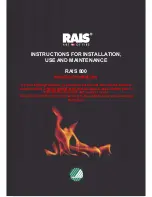
18
Willow Multifuel Stove
OPERATING INSTRUCTIONS
CLEANING
Important; Under some circumstances soot can quickly
build up on the throat plate and adjacent areas. The
throat plate should be removed and checked monthly,
and any debris stripped off. Similarly, clean the upper
surface of the firebox.
ANNUAL MAINTENANCE
It is important that your fire is regularly serviced in
accordance with these instructions. This should be
carried out at least annually by a qualified person and
should consist of the following.
Remove the firebricks lining and throat plate, inspect all
gasketing on doors, glass etc., and re-order any items
that may need replacing, from your Valor dealer. With
a wire brush clean inside the appliance paying attention
to the small inlet holes on the fire door.
Sweep the chimney and confirm that it is sound.
Examine all joints in the flue pipe etc., and re-seal if
necessary. Reassemble and leave with the air inlet and
air wash control about half way open. This will allow a
free flow of air through the appliance thus preventing
moisture and condensation from building up inside the
fire and chimney.
CHIMNEY SWEEPING
Sweeping should be carried out with an appropriate
sized bristle brush and rods to suit chimney size and
type. As with all appliances regular sweeping of the flue
is essential to avoid the danger of blockage and the
escape of poisonous fumes. Access for cleaning should
also be incorporated in the chimney (e.g. soot door or
access through register plate).
Any existing chimney should be swept prior to
installation of the appliance, and swept again a second
time
within one month
of regular use after installation
to establish frequency of sweeping required. This
should be done by a competent person such as a NACS
chimney engineer who will provide a Certificate of
Chimney Sweeping.
The whole flue way including the outlet must be swept
at least twice per burning season. It is important that the
flue ways, flue pipe and chimney be cleaned prior to
lighting the fire after a prolonged shut-down period.
DOOR GLASS
The door glass should remain clear during normal
daytime burning. However under certain conditions-such
as burning at a low rate with damp wood, or overnight
burning, the glass may become somewhat blackened. To
remedy this, operate the appliance at a fast rate.
Alternatively when the stove is cold open the door and
clean the inside face of the glass with a damp cloth or
with glass cleaner (available from fire stockists). Apiece
of cloth moistened with vinegar and dipped in wood ash
-
not coal ash
- will provide a good soft scourer to
remove the soot without scratching the glass.
OUTER FINISH
The outside finish of the appliance is a durable high
temperature paint. It is best cleaned by brushing down
with a clean shoe brush. Do not allow moisture to remain
on the appliance whilst cold or surface rust may form.
The high temperature paint should not require attention
for some time, depending on use. The hotter the fire
burns the sooner repainting will be necessary. Aerosol
tins of paint are available for complete refurbishing.
Before repainting make sure that the fire is out and is
cold.
•Remove the door glass.
•Lightly wire brush, or rub with wire wool, the body of
the appliance to remove any loose paint
powder.
•Mask or remove items such as brass work.
•Any adjacent brickwork, mantelpiece, hearth, etc.,
should be carefully masked for quite a distance around
the appliance. (this precaution is to prevent
discolouration of the surrounding brickwork,
wallpaper etc).
Re-spray in a well-ventilated area - avoid breathing
the vapour. Refer to safety instructions on paint
cans.
•When the paint is dry refit door glass and any other
parts previously removed.
•Leave the appliance for eight hours before-lighting.
•Burn slowly for the first four hours, then build up heat
gradually to cure the paint.
Note: Use only genuine Valor touch-up spray as some
paints interact. This could ruin the finish and
invalidate the guarantee.





































